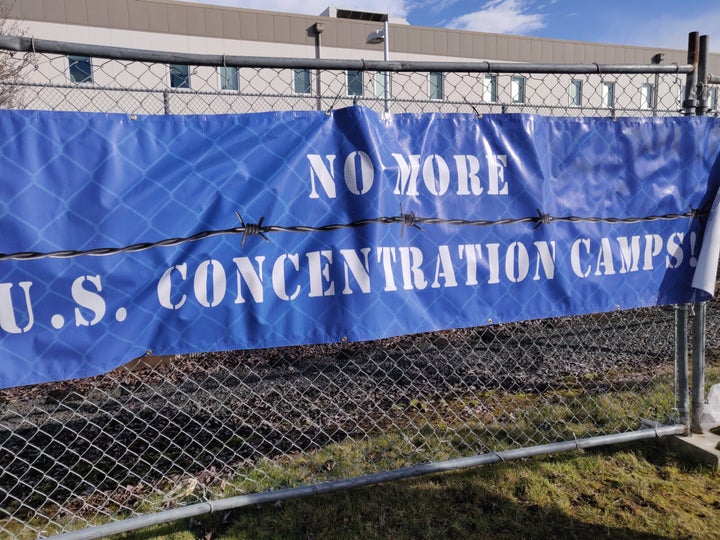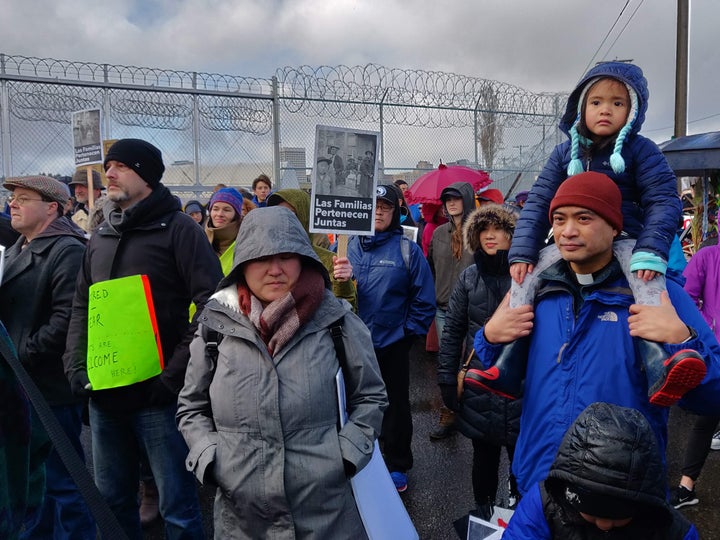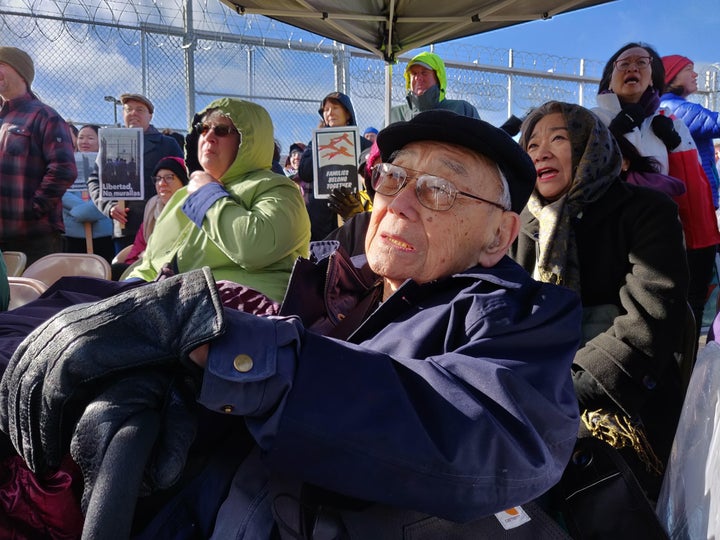Once Put In Concentration Camps, Japanese Americans Rally For Detained Immigrants
TACOMA, Wash. — My 95-year-old grandfather, Homer Yasui, has never been one to dwell on trauma. He’s tough and blunt and funny, and as the keeper of our family history, he’s described his incarceration matter-of-factly many times: how the FBI took his father away on Dec. 12, 1941, five days after the Japanese attacked Pearl Harbor, and how the government ultimately sent his family to a concentration camp.
It’s rare that he reveals any pain over what he and the rest of his family went through. But he’s outraged now as he watches history repeat itself.
“Imagine putting immigrant children in a prison because their parents brought them to the United States perhaps illegally,” he said. “Throw ’em in jail? This is supposed to be a country of refuge and salvation and asylum, and here we’re treating them like criminals and putting people in jail!”
That’s why last Sunday morning, as black clouds loomed in the south and the weather forecast predicted sheets of rain all day, he donned his Tsuru for Solidarity T-shirt and dressed head to toe in black — “I look like a ninja,” he joked — to go to a protest outside the Northwest Detention Center in Tacoma, Washington.
At the detention center, a handful of volunteers set up tents and hung paper cranes — tsuru, as they’re known in Japanese — on the cyclone fence. Each colorful strand of paper birds was tucked into a plastic bag to protect it from the elements. In Japan, it’s believed that folding 1,000 cranes will make one’s wish come true. For Japanese Americans activists, the cranes are a reminder of their history and an expression of solidarity with communities experiencing racist incarceration today.
Despite the unpromising weather, a crowd of about 400 people would soon show up for one of the first big actions organized by the Seattle chapter of Tsuru for Solidarity, a project led by Japanese Americans calling for an end to immigrant detention and incarceration. On June 6, Tsuru delegations from around the country will converge in Washington, D.C., with 126,000 paper cranes — representing the number of people of Japanese ancestry incarcerated in the U.S. during World War II — to stage a massive demonstration calling for closure of the immigrant detention camps and an end to the Trump administration’s targeting of immigrant communities through mass arrests, family separation, detention and deportation.
My grandfather hopes to be among them. After all, he experienced incarceration and family separation firsthand. Like other Japanese immigrant men — “enemy aliens” — who were influential in their communities, my great-grandfather, Masuo, was apprehended suddenly, without explanation, and denied legal representation. He never had a trial.

Grandpa remembered coming home from school on that Friday with his little sister and finding their father gone. “When we asked my mother where father was, she said ‘Torareta’ in Japanese. That means ‘He was taken.’” She didn’t know where.
It took the family two days to learn that Masuo and other immigrant leaders had been taken to the Multnomah County Jail in Portland, Oregon, an hour away. “We knew the ax was gonna fall,” Grandpa explained — Japanese men had already been rounded up in the days following Pearl Harbor, and his father was a well-known businessman. “I wouldn’t say we panicked, we weren’t even shocked, really; we were just really disheartened. That’s what it was.”
No one knew anything. Even if they did, the family couldn’t drive to Portland to see Masuo without passing Bonneville Dam, an area off-limits to people of Japanese descent. Soon, they couldn’t travel anywhere at all — and then, on May 5, 1942, the government came to take them away, too.
“Those were such chaotic days, I don’t really remember the details,” Grandpa told me at the protest, his hands fidgeting. “78 years ago is a long time to remember.”
Nearby, another family was experiencing its own grief. Outside the gates of the Northwest Detention Center, a woman named Angela stood in the cold with her young daughter, Joanna, watching a growing group of protesters mass on the sidewalk with colorful signs in English and Spanish. She wasn’t there to protest; she had driven from Portland to visit her husband, who was detained inside.
Immigration and Customs Enforcement (ICE) took him away on Feb. 18 as he was on his way to work, Angela said in Spanish, hesitant to give any more personal information. He tried to call her at her job, where she’d been since six in the morning, but “they don’t let us answer the phone,” she said. All she knew was that something terrible had happened.
Eventually, Angela’s brother-in-law got word to her that ICE had taken her husband. “At that moment, I thought, no, no, I felt like I was going to faint,” she said. Angela and her husband have been in the U.S. since 1995; their daughter was born here. It felt like my grandfather’s experience all over again.
Last year, about 50,000 people were in ICE custody on an average day. And up to 200 people are transferred to the Northwest Detention Center, now formally known as Northwest ICE Processing Center, every month to await the outcomes of their immigration cases, according to the grassroots group La Resistencia. There’s a litany of complaints about the conditions at the facility: One detainee who spoke anonymously to the crowd from inside the center on Sunday described insects in the food, labor exploitation and abuse, and inadequate medical care ― he had to wait three months to get a tooth taken out, he said, while another man almost died of a heart attack because he didn’t get medical help in time. “We are getting treated like animals, less than animals,” he said.
The center is owned and operated by GEO Group, which did not respond to HuffPost’s request for comment on the conditions inside it and the calls for its closure.
But the conditions aren’t activists’ greatest source of outrage. It’s the fact that such facilities exist at all.
“It’s shiny and it’s horrible,” Maru Mora-Villalpando, an undocumented activist and co-founder of La Resistencia told the crowd Sunday. “Paint it whatever color you want, put whatever mattresses you want to put inside; it’s still a cage. We don’t want better conditions, we don’t want reforms, we don’t want it painted gold — we want it shut down.”
During the protest, Mora-Villalpando led the crowd in a series of English- and Spanish-language chants. “No More! Basta! Shut it down!” Taiko drums thundered, music from a Japanese flute floated over the crowd, and musician Kishi Bashi, who had flown across the country to participate, took the stage with a violin as the storm threatened overhead.
Speakers from the Japanese American public history organization Densho and the Seattle chapter of the Japanese American Citizens League described why they had partnered with La Resistencia in organizing the day’s demonstration and pledged to continue standing together to close the center and end private prisons in the state.
The scale of the June protest will be much larger. Tsuru for Solidarity chapters nationwide have already organized numerous “tsuru fold-ins” to deliver all 126,000 paper cranes in time for the demonstration. There are plans for cross-country bus caravans, meetings with lawmakers, intergenerational healing circles — and a contingent of Japanese American survivors of the wartime incarceration and their descendants marching through the capital, accompanied by 100 taiko drums.
Mike Ishii, a lead organizer of Tsuru for Solidarity who was at Sunday’s protest, expects the June event to be “the largest gathering of Nikkei [Japanese descendants] since World War II.” The rallying cry: “Never Again Is Now.”

Japanese Americans at Sunday’s protest echoed that sentiment. “I’m participating in this because I see it as an opportunity to do what my dad said,” said Susan Yorozu Tripp, 71, whose father was incarcerated in 1942 and later served in the U.S. Military Intelligence Service. “He said they got the executive order, they lined up and they did exactly what they were supposed to do ‘like lambs to slaughter,’ and he said, ‘I hope you never let this happen again.’”
Mizu Sugimura, 64, was born 10 years after her parents “got out of camp.” She carried a decorated baby blanket on Sunday to symbolize their efforts to start anew after the war. “They’re bringing me home and they’re hopeful for the future, new baby, everything. But you carry all of your experiences with you,” she said of the lingering effects of her parents’ incarceration, passed down to the next generation. “I think it’s kind of a way that I can communicate to other people … how something that happened before you were born affects you.”
Sugimura turned toward the building behind the fence. “They are going to be carrying this with them,” she said of the people inside. “Even if tomorrow all of these facilities were [closed], they’re going to carry this with them for the rest of their lives, like my parents and my grandparents.”
With any luck, Grandpa will be one of the Japanese American camp survivors taking Tsuru for Solidarity’s “never again” message directly to Washington, D.C., in June, though perhaps not to Donald Trump.
“No, no! I’m afraid he’ll tweet something back at me,” he said of not wanting to talk to the president. “He might fire me!”
But he did have a message for everyone else: “I want more people to get involved. Stand up, do something! Be counted. Help us.”
“My fervent hope is that my health will allow me to travel to Washington, D.C., and carry a placard or a string of tsuru, or something to demonstrate against the racist policies of our federal government,” he said. “I think it is my duty, while I’m still able to say something and still able to walk, to protest.”

Published at Thu, 27 Feb 2020 02:16:16 +0000